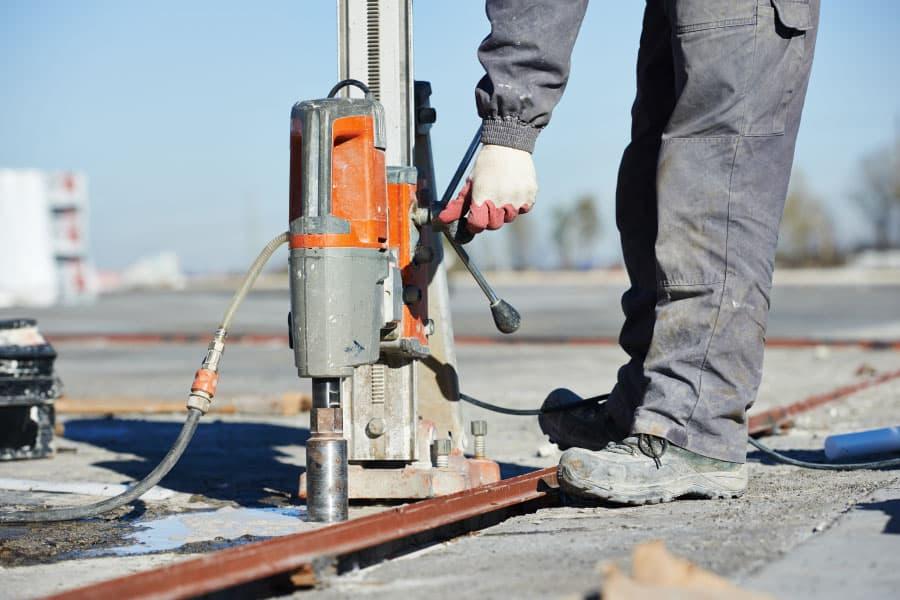Concrete is one of the most used materials in the world because of how affordable, available, and practical it is as a structural material. There are many ways that concrete is worked with, ranging from creating the foundation to attaching things to it. To attach things to concrete, especially for other materials like wood or metal, you’ll need to anchor things in place.
To drill into new concrete, you’ll have to wait around 3-7 days, depending on what you intended to do with your drilled hole. The concrete must set properly and have a certain percentage of its full strength before anything can be done.
In this article, we’ll be going into how concrete curing works, what anchoring actually does, and how drilling holes are made on concrete. Read on, especially if you’re wondering why construction projects take months on end to complete.
Why do we cure concrete?
Concrete, if left uncured, will end up brittle and won’t be as strong as it could possibly be. Curing involves manipulating the nearby environment to provide moisture to the concrete to harden into a stronger finished product. Think about it this way; concrete is partly made up of sand, and just compare dry sand to wet sand.
Curing can range from something as simple as just wetting the concrete throughout a certain interval, depending on what type of concrete you’re going for and the nearby weather conditions, or it could go to something as complex as putting insulating blankets over the concrete to prevent moisture loss due to low temperatures.
What are the stages of concrete setting?
- As concrete is placed, it begins to form as it dries up. The longer it has been set in a certain place, and the longer it takes on a certain shape, the concrete becomes stronger and stronger.
- Before the concrete is approved for construction, it must first go through a standardized pressure test to ensure that it can withstand loads of a building. Optimally, there are 3 concrete blocks created for this test, and each concrete block is subjected to the test at different periods.
- The first block is tested just a week after the concrete block has been made. From this early stage alone, construction managers will tell if something is wrong with the concrete based on its early performance under the pressure machine (like a hydraulic press).
- If the first block passes the test, then the second block will be tested at around 20 days after the blocks were made. If the second block passes, then the third and final block will be tested.
- The 28-day mark is the industry standard as to when the concrete should reach its maximum strength. This part of the construction process takes a long time, especially if the construction workers don’t get the concrete mixture right.
How to drill holes into concrete
Drilling into concrete is not too complicated. Since the concrete has been cured properly and given the necessary moisture throughout its setting, it won’t crack or break when a concentrated force is applied to it.
- Use a specialized drill when going into it. The drill for concrete and other masonry materials will be different compared to those used for wood. The difference lies in the drill’s tip, which is usually a thicker end compared to the wooden drill’s sharp and thin one.
- Drill slowly at first. Again, this isn’t wood, so different rules will apply. Going at full speed at the start may damage your drill, so the best approach is to make a small hole just to set the drill into its proper position, allowing it to apply force into the concrete better.
- As you drill, dust will begin to accumulate inside the hole. It’s a good practice to have a clean workspace and get any debris out of the way. Simple pull the drill out every now and then so it can take the dust along with it. You can also use pressurized air to get the dust out, which is especially useful for holes that are made on the horizontal plane.
- Hammer and nails can also be used, especially for really hard concrete. The force from a nail is different because of its direction and how the force is applied to it, allowing you to go deeper into the concrete.

How to anchor into concrete
Now that you’ve drilled a hole into your concrete blocks, what’s next?
Anchoring is attaching other parts of the building into the concrete. From the holes drilled into the concrete, the fixtures are bolted in and secured.
To make it simple, imagine anchoring as a medium to which you can attach objects to.
Here’s a very simplified step by step way of how anchoring is done:
- You drill the hole into the concrete.
- You fill the concrete hole with an anchoring. The anchoring provides another hole that is designed to be compatible with fixtures (think about your regular bolts, screws, or nails.)
- The fixture is then attached. The anchoring translates the forces that are required to hold up the fixture to the concrete.
There is really not that much that goes into it. It’s as if you’re just installing a nail onto a wooden wall to make sure your pictures don’t fall off. It’s exactly the same thing with anchoring, except anchoring is more heavy-duty.
This article, of course, tackles the typical house application of anchoring. The more industrial and complex structures use anchoring as an additional structural component. These little forces add up to a bigger force that needs to be accounted for. If done over thousands of times in a skyscraper, something as simple as multiple fixtures can cause a significant change in how the building holds up.
Attaching things and a short lesson on physics
What’s the difference between screws, bolts, nails, or practically any other fastener.
The main difference is how these different fasteners apply force to an object. Different factors such as the force needed, the angle, the material being worked with, and conditions determine what type of fastener is used.
Forces can either be compressive or tension (push or pull). Things like screws and bolts are better for pulling forces, while nails would be better for pushing forces.
It’s important to know this, especially if you plan on fastening something like an oven or a tv to a wall. The last thing you need is a smashed oven in your kitchen or a TV falling over in your living room.
So when you plan on fastening things, make sure you know what’s the appropriate fastener to use.
Conclusion
Again, concrete is such a popular material that people worldwide are always finding new ways to work with it. Drilling holes into concrete may sound scary or difficult, but it’s actually not. Using the right tools designed for the job allows you to work with concrete as if it were just like wood.
The opportunities for learning more about what you can and can’t change about your home are important, especially for homeowners that like to redecorate. Anchoring can be used to easily set up another wall in a jiffy or just to secure certain pieces of furniture (like an oven stand, for example) to the floor.

 Dior Women's Pearl Earrings CD
Dior Women's Pearl Earrings CD  Dior CD Disc-shaped Earrings 2023 Vintage Style for Women
Dior CD Disc-shaped Earrings 2023 Vintage Style for Women  Chanel earrings, CC earrings adorned with stones v42
Chanel earrings, CC earrings adorned with stones v42  Chanel earrings, CC dangle earrings in water drop shape adorned with stones and pearls v39
Chanel earrings, CC dangle earrings in water drop shape adorned with stones and pearls v39 